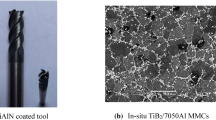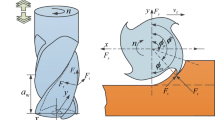Abstract
The particle reinforced metal matrix composites have drawn attractive attentions in modern industries due to their excellent properties such as low density, improved strength, and wear resistance. However, due to the existence of hard ceramic particles, it shows poor machinability such as large cutting force and unstable machined surface quality using traditional cutting method. In this study, taking advantage of ultrasonic vibration–assisted cutting method such as reducing cutting force and improving machining quality, the machined surface integrity of a new kind of in situ TiB2/7050Al metal matrix composites was comparatively investigated between conventional milling (CM) and ultrasonic vibration–assisted milling (UVM). It was much important to match appropriate ultrasonic vibration parameters and cutting parameters for achieving a smaller surface roughness and larger surface compressive residual stress in UVM. The depth of compressive residual stress layer in the subsurface was about 90 to 120 μm, which was deeper than that of CM. Besides, ultrasonic vibration did not make obvious impact on the surface hardness and microhardness. In this paper, for ultrasonic vibration–assisted milling in situ TiB2/7050Al MMCs, the vibration parameters and cutting parameters were recommended as frequency of 30 kHz, amplitude of 4 μm, cutting speed of 30 m/min, feed rate of 0.05 mm/z, and cutting depth of 0.5 mm; the surface roughness was 0.34 μm and compressive surface residual stress was − 208 MPa. Therefore, a proper match of ultrasonic parameters and cutting parameters could significantly enhance the surface integrity in ultrasonic vibration–assisted milling in situ TiB2/7050Al MMCs.






















Similar content being viewed by others
Data availability
All authors confirm that the data supporting the findings of this study are available within the article.
Code availability
Not applicable.
References
Xiong YF, Wang WH, Shi YY, Jiang RS, Lin KY, Liu XF (2020) Fatigue behavior of in-situ TiB2/7050Al metal matrix composites: fracture mechanisms and fatigue life modeling after milling. Int J Fatigue 138:105698
Gobalakrishnan B, Lakshminarayanan PR, Varahamoorthi R (2017) Combined effect of TiB2 particle addition and heat treatment on mechanical properties of Al6061/TiB2 in-situ formed MMCs. J Adv Microsc Res 12(3):230–235
Sekhar R, Singh TP (2015) Mechanisms in turning of metal matrix composites: a review. J Market Res 4(2):197–207
Liu XF, Wang WH, Jiang RS, Xiong YF, Lin KY (2020) Tool wear mechanisms in axial ultrasonic vibration assisted milling in-situ TiB2/7050Al metal matrix composites. Adv Manuf 8(2):252–264
Yang ZC, Zhu LD, Zhang GX, Ni CB, Lin B (2020) Review of ultrasonic vibration-assisted machining in advanced materials. Int J Mach Tools Manuf 56:103594
Liu XF, Wang WH, Jiang RS, Xiong YF, Lin KY, Li JC, Shan CW (2021) Analytical model of cutting force in axial ultrasonic vibration-assisted milling in-situ TiB2/7050Al PRMMCs. Chin J Aeronaut 34(4):160–173
Philipp MR, Alpcan G, Robin K, Michael FZ (2020) Experimental investigations on longitudinal-torsional vibration-assisted milling of Ti-6Al-4V. Int J Adv Manuf Technol 108(11):3607–3618
Liu Y, Liu ZB, Wang XB, Huang T (2020) Experimental study on tool wear in ultrasonic vibration-assisted milling of C/SiC composites. Int J Adv Manuf Technol 107(1):425–436
Gupta MK, Song QH, Liu ZQ, Sarikaya M, Jamil M, Mia M, Khanna N, Krolczyk GM (2021) Experimental characterisation of the performance of hybrid cryo-lubrication assisted turning of Ti-6Al-4V alloy. Tribol Int 153:106582
Dong GJ, Zhang HJ, Zhou M, Zhang YJ (2013) Experimental investigation on ultrasonic vibration-assisted turning of SiCp/Al composites. Mater Manuf Processes 28(9):999–1002
Puga H, Grilo J, Carneiro VH (2019) Ultrasonic assisted turning of Al alloys: influence of material processing to improve surface roughness. Surfaces 2(2):326–335
Zhu LD, Ni CB, Yang ZC, Liu CF (2019) Investigations of micro-textured surface generation mechanism and tribological properties in ultrasonic vibration-assisted milling of Ti-6Al-4V. Precis Eng 57:229–243
Chen G, Zou YH, Qin XD, Liu J, Feng Q, Ren CZ (2020) Geometrical texture and surface integrity in helical milling and ultrasonic vibration helical milling of Ti-6Al-4V alloy. J Mater Process Technol 278:116494
Li X, Yang SL, Lu ZH, Zhang DY, Zhang XY, Jiang XG (2020) Influence of ultrasonic peening cutting on surface integrity and fatigue behavior of Ti-6Al-4V specimens. J Mater Process Technol 275:116386
Geng DX, Zhang DY, Xu YG, He FT, Liu DP, Duan ZH (2015) Rotary ultrasonic elliptical machining for side milling of CFRP: Tool performance and surface integrity. Ultrasonics 59:128–137
Chen J, Ming WW, An QL, Chen M (2020) Mechanism and feasibility of ultrasonic-assisted milling to improve the machined surface quality of 2D Cf/SiC composites. Ceram Int 46:15122–15136
Peng ZL, Zhang XY, Zhang DY (2021) Improvement of Ti-6Al-4V surface integrity through the use of high-speed ultrasonic vibration cutting. Tribol Int 160:107025
O’Toole L, Kang CW, Fang FZ (2020) Advances in rotary ultrasonic-assisted machining. Nanomanufacturing and Metrology 3(1):1–25
Guo P, Ehmann KF (2013) An analysis of the surface generation mechanics of the elliptical vibration texturing process. Int J Mach Tools Manuf 64:85–95
Sajjady SA, Abadi HNH, Amini S, Nosouhi R (2016) Analytical and experimental study of topography of surface texture in ultrasonic vibration assisted turning. Mater Des 93:311–323
Börner R, Winkler S, Junge T, Titsch C, Schubert A, Drossel WG (2018) Generation of functional surfaces by using a simulation tool for surface prediction and micro structuring of cold-working steel with ultrasonic vibration assisted face milling. J Mater Process Technol 255:749–759
Yuan YJ, Zhang DW, Jing XB, Zhu HY, Zhu WL, Cao J (2019) Fabrication of hierarchical freeform surfaces by 2D compliant vibration-assisted cutting. Int J Mech Sci 152:454–464
Ning FD, Wang H, Cong WL (2019) Rotary ultrasonic machining of carbon fiber reinforced plastic composites: a study on fiber material removal mechanism through single-grain scratching. Int J Adv Manuf Technol 103(1):1095–1104
Tong JL, Zhao JS, Chen P, Zhao B (2020) Effect of ultrasonic elliptical vibration turning on the microscopic morphology of aluminum alloy surface. Int J Adv Manuf Technol 106:1397–1407
Luo H, Wang YQ, Zhang P (2020) Effect of cutting and vibration parameters on the cutting performance of 7075–T651 aluminum alloy by ultrasonic vibration [J]. Int J Adv Manuf Technol 107:371–384
Chen P, Tong JL, Zhao JS, Zhang ZM, Zhao B (2020) A study of the surface microstructure and tool wear of titanium alloys after ultrasonic longitudinal-torsional milling. J Manuf Process 53:1–11
Singh H, Haq MIU, Raina A (2020) Dry sliding friction and wear behaviour of AA6082-TiB2 in situ composites. SILICON 12(6):1469–1479
Kumar PS, Krishna VM, Kavimani V, Prakash KS, Kumar GS (2020) Effect of TiB2 on the corrosion resistance behavior of in situ Al composites. Int J Metalcast 14(1):84–91
Gobalakrishnan B, Rajaravi C, Udhayakumar G, Lakshminarayanan PR (2020) Effect of ceramic particulate addition on aluminium based ex-situ and in-situ formed metal matrix composites. Met Mater Int. https://doi.org/10.1007/s12540-020-00868-6
Xiong YF, Wang WH, Jiang RS, Lin KY, Song GD (2016) Tool wear mechanisms for milling in situ TiB2 particle-reinforced Al matrix composites. Int J Adv Manuf Technol 9(86):3517–3526
Yu WW, Li YG, Chen J, Zuo ZY, Chen D, An QL, Chen M, Wang HW (2020) Experimental study on chip formation and surface quality in milling of TiB2/Al alloy composites. Mater Manuf Processes 35(15):1671–1679
Liu XF, Wang WH, Jiang RS, Xiong YF, Lin KY, Li JC (2020) Investigation on surface roughness in axial ultrasonic vibration assisted milling in-situ TiB2/7050Al MMCs. Int J Adv Manuf Technol 111(1–2):63–75
Xiong YF, Wang WH, Shi YY, Jiang RS, Shan CW, Liu XF, Lin KY (2021) Investigation on surface roughness, residual stress and fatigue property of milling in-situ TiB2/7050Al metal matrix composites. Chin J Aeronaut 34(4):451–464
Pugazhenthi A, Kanagaraj G, Dinaharan I, Selvam JDR (2018) Turning characteristics of in situ formed TiB2 ceramic particulate reinforced AA7075 aluminum matrix composites using polycrystalline diamond cutting tool. Measurement 121:39–46
Pugazhenthi A, Dinaharan I, Kanagaraj G, Selvam JDR (2018) Predicting the effect of machining parameters on turning characteristics of AA7075/TiB2 in situ aluminum matrix composites using empirical relationships. J Braz Soc Mech Sci Eng 40:555
Yu WW, Chen J, Li YG, Zuo ZY, Chen D, An QL, Chen M, Wang HW (2021) Comprehensive study on the cutting specific energy and surface roughness of milled in situ TiB2/Al composites and Al alloys. Int J Adv Manuf Technol 112:2717–2729
Acknowledgements
Many thanks to the ultrasonic vibration equipment support from Xi’an Chao Ke Neng Ultrasonic Technology Research Institute Co. Ltd.
Funding
This work is sponsored by the National Science and Technology Major Project (Grant No. 2017-VII-0015–0111), National Natural Science Foundation of China (Grant No. 51775443), and China Postdoctoral Science Foundation (Grant No. 2020M683569).
Author information
Authors and Affiliations
Contributions
Xiaofen Liu: guidance and planning of the overall thinking, optimized and guided the experimental process, performed data measurement and analysis, wrote the first draft, and revised the contents of the first draft. Wenhu Wang: provided financial support for materials and equipment, supervision, and reviewing the first draft. Ruisong Jiang: checking and reviewing the first draft. Yifeng Xiong: responsible for the planning of the overall thinking, experimental process and data analysis, revised and reviewed the first draft. Chenwei Shan: funding acquisition and financial support. All the authors read and approved the final manuscript.
Corresponding author
Ethics declarations
Ethics approval
The manuscript has not been submitted to any other journal for simultaneous consideration. The submitted work is original and has not been published elsewhere in any form or language.
Consent to participate
All authors voluntarily agree to participate in this research study.
Consent for publication
All authors voluntarily agree to publish this research study.
Conflict of interest
The authors declare no competing interests.
Additional information
Publisher's Note
Springer Nature remains neutral with regard to jurisdictional claims in published maps and institutional affiliations.
Rights and permissions
About this article
Cite this article
Liu, Xf., Wang, Wh., Jiang, Rs. et al. Comparative investigation on surface integrity for conventional and ultrasonic vibration–assisted cutting of in situ TiB2/7050Al MMCs. Int J Adv Manuf Technol 120, 1949–1965 (2022). https://doi.org/10.1007/s00170-022-08862-5
Received:
Accepted:
Published:
Issue Date:
DOI: https://doi.org/10.1007/s00170-022-08862-5




